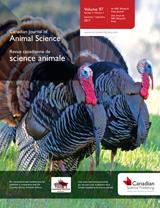Three ensiled barley varieties (‘CDC Cowboy’, ‘CDC Copeland’, and ‘Xena’) selected for differences in 30 h neutral detergent fiber digestibility (NDFD30h) were fed at two (LOW and HIGH) inclusion rates to study their effects on performance of crossbred steers (n = 288) in a 3 × 2 factorial design. Diets with the LOW inclusion level during backgrounding had a 1:1 barley silage:barley grain ratio, whereas HIGH diets had a 2:1 ratio (% DM basis). Respective ratios during finishing were 1:17 and 1:5. Actual NDFD30h averaged 37.6% ± 3.5%, 34.7% ± 3.8%, and 36.9% ± 3.0% for ‘CDC Cowboy’, ‘CDC Copeland’, and ‘Xena’, respectively. Backgrounding diets containing ‘CDC Cowboy’ as well as the HIGH diets had greater (P < 0.01) acid detergent fiber (ADF) and neutral detergent fiber (NDF) content. Steers fed ‘CDC Cowboy’ as well as the HIGH diets during backgrounding had lower (P < 0.01) dry matter intake (DMI), average daily gain (ADG), and end of backgrounding body weight. During finishing, ADG and DMI were greater (P < 0.01) for steers fed HIGH barley silage diets. The results indicate that barley variety and inclusion level had the greatest impact during backgrounding and highlight the difficulty in choosing barley varieties for silage based on a single nutritional parameter like NDFD30h.
How to translate text using browser tools
19 August 2017
Effect of variety and level of inclusion of barley varieties for silage selected to vary in neutral detergent fiber digestibility on performance and carcass characteristics of growing and finishing beef steers
Jayakrishnan Nair,
David Christensen,
Peiqiang Yu,
Tim McAllister,
Natalie Preston,
Daalkhaijav Damiran,
John J. McKinnon
ACCESS THE FULL ARTICLE
It is not available for individual sale.
This article is only available to subscribers.
It is not available for individual sale.
It is not available for individual sale.





